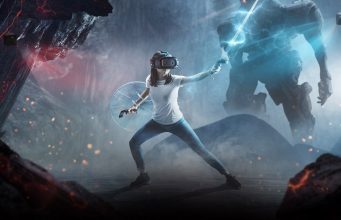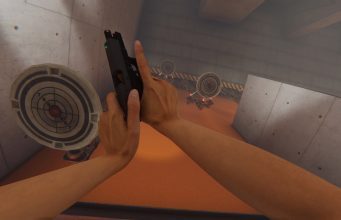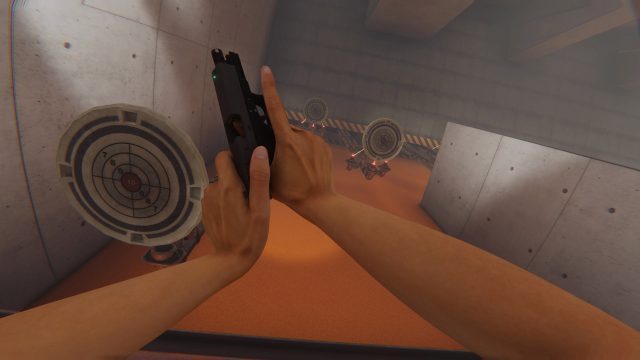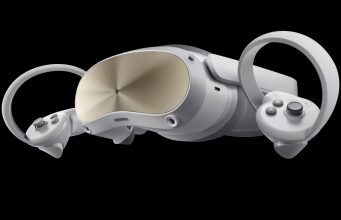Bonelab, the sequel to the 2019 hit Boneworks from Stress Level Zero, is available now on Meta Quest 2 and PC VR. Does it live up to the hype? Here’s our full Bonelab review.
As one of the most anticipated VR releases of the year, Bonelab has some pretty big shoes to fill. Its predecessor Boneworks may not have been perfect, but it was incredibly popular and is often regarded as a seminal VR title.
Three years later, Bonelab carries that legacy forward and onto Quest 2 for the first time, bringing the franchise to a whole new player base. Stress Level Zero has grafted the meat and muscle from Boneworks to create Bonelab, a follow-up that shares much of the DNA of its fore-bearer – for better and for worse.
Boneworks introduced a novel approach towards interactions in VR, giving all items a real sense of weight and openly inviting the player to roleplay along with the game. The game advised players that “if you physically imagine you are holding the heavy object, you will have an easier time moving it.”
That’s the core philosophy driving Stress Level Zero’s Marrow1 Interaction Engine, developed for Boneworks and now used in Bonelab. Everything you loved (and perhaps hated) about Boneworks’ interactions have transferred across into Bonelab. This means you’ll have to act out in pantomime when lifting objects for the best results, but it also means there’s the same level of playfulness, unpredictability and experimentation too.
A New Structure
However, Stress Level Zero takes a slightly different approach to the game’s overall structure this time around. Opening the game for the first time, you’ll begin the main campaign. After about 15 minutes, you’re introduced to a new hub area called The Lab. It’s here that you’ll start to realise the full scope of Stress Level Zero’s vision – the campaign is just one facet of what’s on offer.
The Lab features a range of minigames, game modes and activities to explore. There’s sandbox environments, wave shooters, time trials and parkour courses, just to name a few. After playing around in The Lab for a bit, you’ll be able to move on with the campaign, but you can return at any point during or after – it becomes a permanent option in the main menu, always accessible. More modes and levels are added as you progress through the campaign and leaderboards allow you to compete globally or among your friends.
After detouring through The Lab, the longest and meatiest section of the Bonelab campaign begins. Much like Boneworks, Bonelab’s campaign is a mix of puzzle platformer and shooter gameplay that encourages you to find creative and unique solutions using the varied tools provided. There’s a mix of enemies – including faceless digital zombies and headcrab-inspired robots – but they rarely pose a real challenge.

The game constantly provides you with new and varied types of weapons to experiment with. Most of the campaign’s fun comes from this experimentation, allowing you to go hell for leather in dramatic fashion as you progress through each area. The more creative you are, the more fun you’ll have. The sandbox system is so open-ended that there were several points where I completed a task and remained uncertain whether I had done it as intended, or whether I invented another solution that just happened to work. The more likely answer is that it doesn’t matter: Bonelab often doesn’t care how you get from A to B, it just wants you to do so in whatever way you can.
The flip side to this is that the physics system can also be incredibly frustrating at times. Climbing a ladder or vaulting onto a ledge is always harder than it needs to be, for example, with body parts getting caught or acting out of place. Likewise, I would often reach for one item on my body, such as my pistol, and end up with something else in my hand, such as ammo. This occasional imprecision with interactions can become frustrating, and gets even worse when mobbed by enemies in close quarters.
All of this will sound pretty familiar to Boneworks players, which features the same premise and inherent problems. That being said, Stress Level Zero does introduce some new mechanics to shake things up. The most prominent is the game’s avatar system, which sees you embody a variety of characters with different physical attributes and stats (speed, weight, strength etc.). You’ll unlock these avatars in a series of worlds featuring minigames and obstacles designed around an avatar’s given strengths or weaknesses. There’s a parkour course for the speedy avatar, for example, or a retro-inspired punch-em-up minigame for the one with super strength.

Once all the avatars are unlocked, you can change between them at will using a unit on your arm. For the rest of the campaign, switching between avatars becomes a new tool to solve environment puzzles or creatively approach encounters. There are some circumstances where you’ll need to use a specific avatar to achieve an outcome, and others where you might just switch because you feel like it. It’s certainly an interesting new mechanic in theory, but in practice the campaign doesn’t always take advantage of it in many interesting ways. You can also freely switch between avatars in The Lab, which is likely where players will find more interesting uses for them.
Narrative, Post-Game Sandbox and Mod Support
In terms of narrative, Bonelab’s story is fairly thin and hands-off. The campaign is definitely a continuation of the universe and threads from Boneworks, but don’t expect many concrete answers or much narrative closure. You’ll explore a series of soulless, abandoned corporate environments and research facilities, as well as a mix of more creative MythOS worlds developed by the former workers of Monogon Industries. The campaign probably took me around six or seven hours to complete in total, but your mileage might vary depending on how fast or slow you play.
Much like with Boneworks, it sometimes feels like the campaign and narrative are playing second fiddle to the wider sandbox toolset that Stress Level Zero are creating in Bonelab. However, improvements to the post-game offering and game modes might make that more acceptable this time around. As mentioned, The Lab is a fantastic hub area with a great array of minigames and game modes to explore. That in itself offers a decent amount for players to return to post-campaign, but there’s one other major addition: mods.
At launch, Bonelab’s mod section will support importing custom avatars to use in-game and will automatically assign stats (strength, speed, etc.) to the avatar based off its silhouette. Stress Level Zero developer Brandon Laatsch says that mod support will expand over time, with plans to include support for custom items, vehicles and more.
Performance Woes
While all of this marks a solid foundation, Bonelab does have some rougher edges on Quest 2.
It’s an achievement that Stress Level Zero managed to get such an ambitious release running on standalone hardware, but it also has some notable and consistent performance issues on Quest 2. During my playthrough, I encountered frequent stutters, frame drops and many moments where it was clear that the headset was struggling to keep up. The game also crashed a number of times and there were several instances where I had to manually quit and restart the game in order to progress. It’s certainly playable, but not a completely smooth experience.

Performance hitches aside, it’s also clear that significant compromises were made to get the game running on Quest 2. Many environments feature a heavy grey fog in the near distance, presumably to obscure short draw distances, and the game employs heavy and noticeable fixed foveated rendering. Textures are quite low in detail and often look garbled from a distance, only resolving to high detail when the player is in very close range.
Despite this, the game still looks decent on standalone hardware given the circumstances. It remains an impressive feat, but the performance is definitely on the lower end for Quest 2.
Bonelab Review – Final Verdict
While Boneworks was a big step forward, Bonelab doesn’t reinvent the wheel. It’s very much an extension of the groundwork laid before it and for some, that will be enough.
For new and returning players, there’s a short campaign with fun moments and interesting mechanics that inspire creative solutions. However, the campaign still verges on feeling like more of an afterthought, conceived as a justification for other sandbox features, game modes and mechanics.

Nonetheless, the sandbox content on offer is quite extensive. The new game modes and burgeoning mod support should hopefully grant a high level of replayability and a long shelf life bolstered by community-made content. It’s early days, but there’s potential for Bonelab to become an ever-evolving sandbox tool that rivals its predecessor. Plus, while the performance isn’t always seamless, Bonelab’s release on Quest 2 brings the franchise to a broader player base than ever before.
With this release, Stress Level Zero offers more of the unpredictable, intense sandbox experience from Boneworks, now available on both standalone and PC VR hardware. If you’re new to VR, easily nauseated or looking for a meaty and extensive campaign, then maybe look elsewhere. But if you’ve got a strong stomach and enjoy other physically-centered games like The Walking Dead: Saints & Sinners, then Bonelab should scratch that itch.
This review was conducted on the Quest 2 version of Bonelab. UploadVR recently changed its review guidelines, and this is one of our new unlabelled review categories. You can read more about our review guidelines here.
What do you think of Bonelab? Let us know in the comments below and keep an eye out for our graphics comparison, coming later today.
from UploadVR https://ift.tt/Mn5RTEg
via IFTTT





 We chose these two examples because a game like Beat Saber, despite being an almost universally comfortable VR game, will have many ‘n/a’ on its list because it completely lacks artificial turning & movement. Whereas a game like Half-Life: Alyx uses artificial turning & movement and therefore offers more options for player comfort.
We chose these two examples because a game like Beat Saber, despite being an almost universally comfortable VR game, will have many ‘n/a’ on its list because it completely lacks artificial turning & movement. Whereas a game like Half-Life: Alyx uses artificial turning & movement and therefore offers more options for player comfort.
















